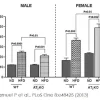- Empty cart.
- Continue Shopping

Triglyceride Assay Kit – Quantification
Triglyceride Assay Kit – Quantification
This product is currently out of stock and unavailable.
Key features and details
- Assay type: Quantitative
- Detection method: Colorimetric/Fluorometric
- Platform: Microplate reader
- Assay time: 1 hr 20 min
- Sample type: Cell Lysate, Other biological fluids, Plasma, Serum, Tissue Extracts, Urine
- Sensitivity: 2 µM
Overview
Product name
See all Triglyceride kits
Detection method
Sample type
Assay type
Sensitivity
Assay time
Product overview
Triglyceride Assay Kit (ab65336) is a sensitive, easy assay to measure triglyceride concentration in mammalian samples. In the triglyceride assay protocol, triglycerides are converted to free fatty acids and glycerol. Glycerol is then oxidized to generate a product which reacts with a probe to generate color (spectrophotometry at λ= 570 nm) and fluorescence (Ex/Em = 535/587 nm).
Triglyceride assay protocol summary:
– add samples and standards to wells
– add assay buffer and lipase, and incubate for 20 min
– add triglyceride reaction mix and incubate for 60 min
– analyze with microplate reader
Please note: the general range is 0-10 nmol (colorimetric) and 0-1 nmol (fluorometric).
If your sample contains reducing substances, they are likely to interfere with the assay. In this case, we recommend using Triglyceride Assay Kit (Fluorometric, Reducing samples) ab178780.
Review our Metabolism Assay Guide to learn about assays for metabolites, metabolic enzymes, mitochondrial function, and oxidative stress, and also about how to assay metabolic function in live cells using your plate reader.
Notes
This product is manufactured by BioVision, an Abcam company and was previously called K622 Triglyceride Quantification Colorimetric/Fluorometric Kit. K622-100 is the same size as the 100 test size of ab65336.
How other researchers have used Triglyceride Assay Kit ab65336
The Triglyceride assay kit has been used in publications in a variety of sample types, including:
– Human: serum1, plasma2, mammary epithelial and mammary cancer cell line lysate3, Huh7.5 hepatocyte-derived cell line lysate4, primary liver cell line lysates5, sebocyte cell culture lysates6
– Mouse: hepatocyte cell lysates7, liver extract8, serum9, plasma10, kidney extracts11, liver tissue and serum12, cardiac tissue extracts13
– Rat: liver tissue extract14, plasma15
– Drosophila16
Abcam has not and does not intend to apply for the REACH Authorisation of customers’ uses of products that contain European Authorisation list (Annex XIV) substances.
It is the responsibility of our customers to check the necessity of application of REACH Authorisation, and any other relevant authorisations, for their intended uses.
Platform
Properties
Storage instructions
| Components | Identifier | 100 tests | 2000 tests |
|---|---|---|---|
| Lipase | Blue | 1 vial | 20 vials |
| Triglyceride Assay Buffer | 1 x 25ml | 20 x 25ml | |
| Triglyceride Enzyme Mix (lyophilized) | Green | 1 vial | 20 vials |
| Triglyceride Probe (in DMSO, anhydrous) | Red | 1 x 200µl | 20 x 200µl |
| Triglyceride Standard (1 mM) | Yellow | 1 x 300µl | 20 x 300µl |
Research areas
- Kits/ Lysates/ Other
- Kits
- Cell Metabolism Kits
- Fatty Acid Assays
- Kits/ Lysates/ Other
- Kits
- Cell Metabolism Kits
- Lipid Metabolism Kits
- Fatty acids
- Kits/ Lysates/ Other
- Kits
- Cell Metabolism Kits
- Lipid Metabolism Kits
- Obesity
- Metabolism
- Types of disease
- Metabolic disorders
- Metabolism
- Pathways and Processes
- Redox metabolism
- Fatty acid oxidation
Relevance
Alternative names
- TG
- Triacylglyceride
- triglycerides






















